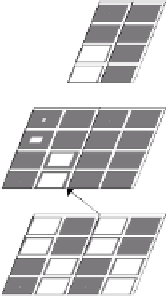Information Technology Reference
In-Depth Information
Dim A Dim B
fact that there are only two such units, one for each di-
mension, with each unit fully connected with the feature
units in the hidden layer from the corresponding dimen-
sion.
During initial learning, the network has no difficulty
activating the target item representation, because all
hidden units are roughly equally likely to get activated,
and the correct item will get reinforced through learn-
ing. However, if the target is then switched to one that
was previously irrelevant (i.e., a reversal), then the ir-
relevant item will not tend to be activated in the hidden
layer, making it difficult to learn the new association.
The top-down PFC biasing can overcome this problem
by supporting the activation of the new target item, giv-
ing it an edge in the kWTA competition.
The AC layer is the adaptive critic for the temporal
differences reward-based learning mechanism, which
controls the dopamine-based gating of PFC represen-
tations and is thus critical for the trial-and-error search
process. In this model, there is no temporal gap be-
tween the stimulus, response, and subsequent reward
or lack thereof, but the AC still plays a critical role
by learning to expect reward when the network is per-
forming correctly, and having these expectations dis-
confirmed when the rule changes and the network starts
performing incorrectly. By learning to expect rewards
during correct behavior, the AC ends up stabilizing the
PFC representations by not delivering an updating gat-
ing signal. When these expectations are violated, the
AC destabilizes the PFC and facilitates the switching to
a new representation.
More specifically, three patterns of AC unit activa-
tion - increasing, constant, and decreasing - affect the
PFC units in different ways. If the network has been
making errors and then makes a correct response, the
AC unit transitions from near-zero to near-1 level acti-
vation, resulting in a positive TD
Æ
value (computed as
the difference in minus and plus phase AC activation,
and indicating a change in expected reward), and thus
in a transient strengthening of the gain on the weights
from the hidden units to the PFC. This causes the PFC
to encode the current pattern of hidden activity. If the
network is consistently making errors or consistently
performing correctly (and expecting this performance),
then there is no change in the AC activation, and the
PFC_Feat
Dim A Dim B
PFC_Dim
Hidden
AC
Dim A
Dim B
Input
Output
LR L R
L
R
Figure 11.12:
Dynamic categorization network: The input
display contains two stimuli - one on the left and one on the
right - and the network must choose one. The two stimuli dif-
fer along two dimensions (Dim
A
and
B
). Individual features
within a dimension are composed of 2 active units within a
column. The Input and Hidden layers encode these features
separately for the left (L) and right (R) side display. Response
(Output) is generated by learned associations from the Hidden
layer. Because there are a large number of features in the in-
put, the hidden layer cannot represent all of them at the same
time. Learning in the hidden layer ensures that relevant fea-
tures are active, and irrelevant ones are therefore suppressed.
This suppression impairs learning when the irrelevant features
become relevant. The prefrontal cortex (PFC) layers (repre-
senting feature-level and dimension-level information) help
by more rapidly focusing hidden layer processing on previ-
ously irrelevant features.
The prefrontal cortex (PFC) areas are
PFC_Feat
,
corresponding to orbital areas that represent featu-
ral information, and
PFC_Dim
, which corresponds
to the dorsolateral areas that represent more abstract
dimension-level information. These areas are recipro-
cally interconnected with the hidden units, and their ac-
tivity thus biases the hidden units. The featural nature
of the
PFC_Feat
representations is accomplished by
having the individual PFC units connect in a one-to-one
fashion with the featural units within the 2 dimensions.
We only included one set of 4 such featural units per
dimension because this area does not encode the loca-
tion of the features, only their identity. The dimensional
nature of the
PFC_Dim
representations comes from the





Search WWH ::

Custom Search